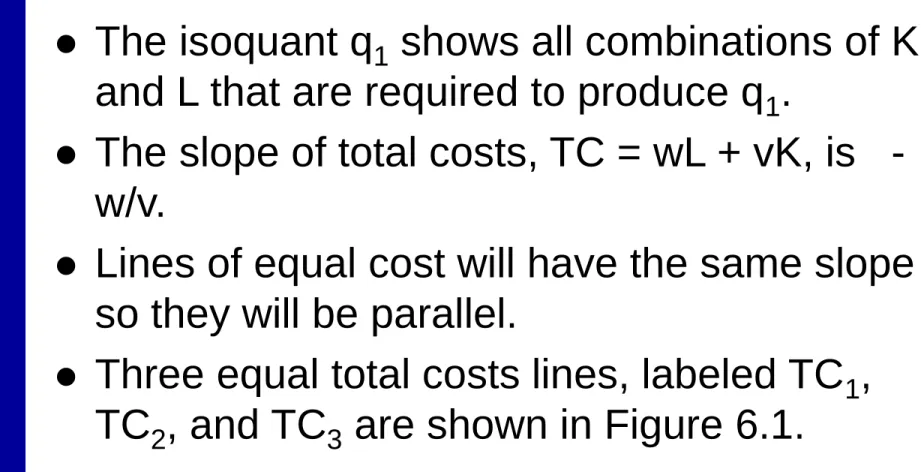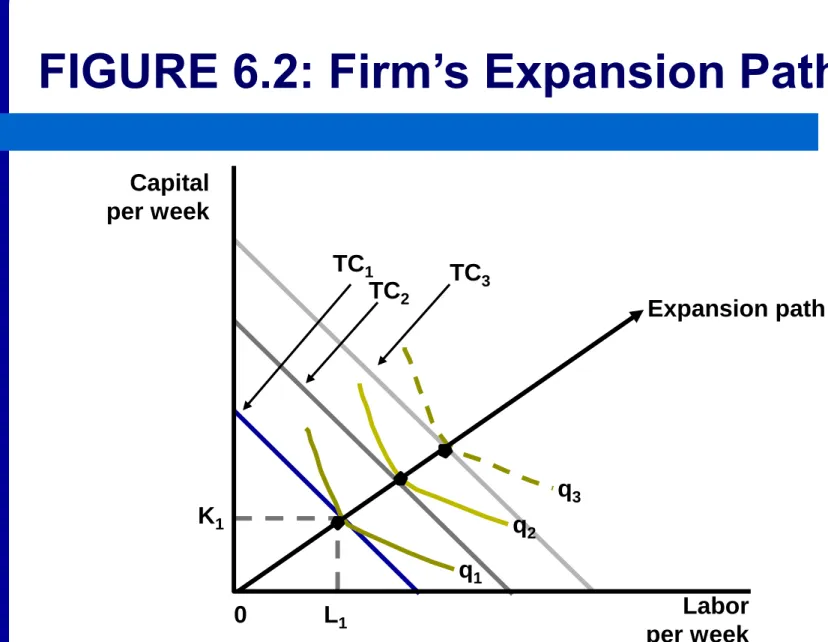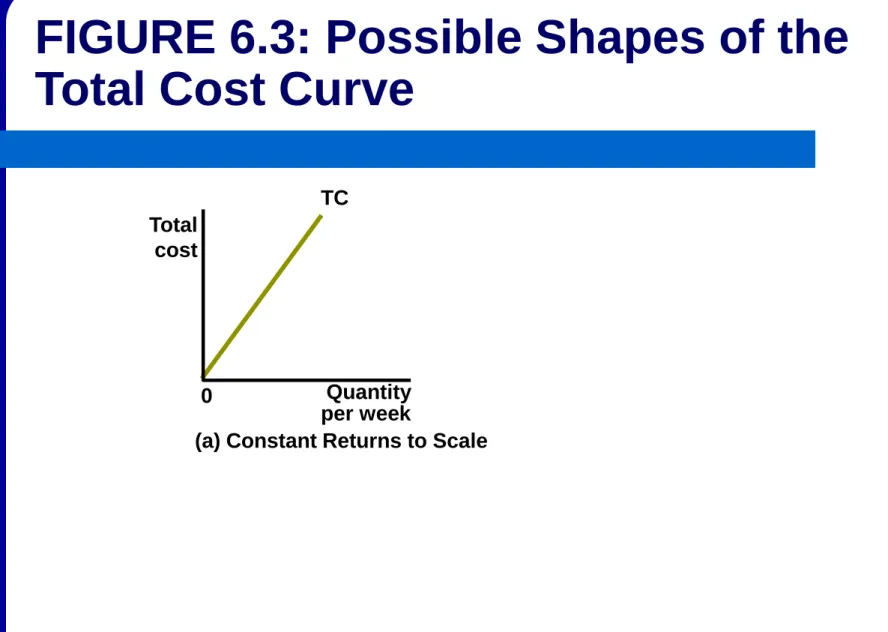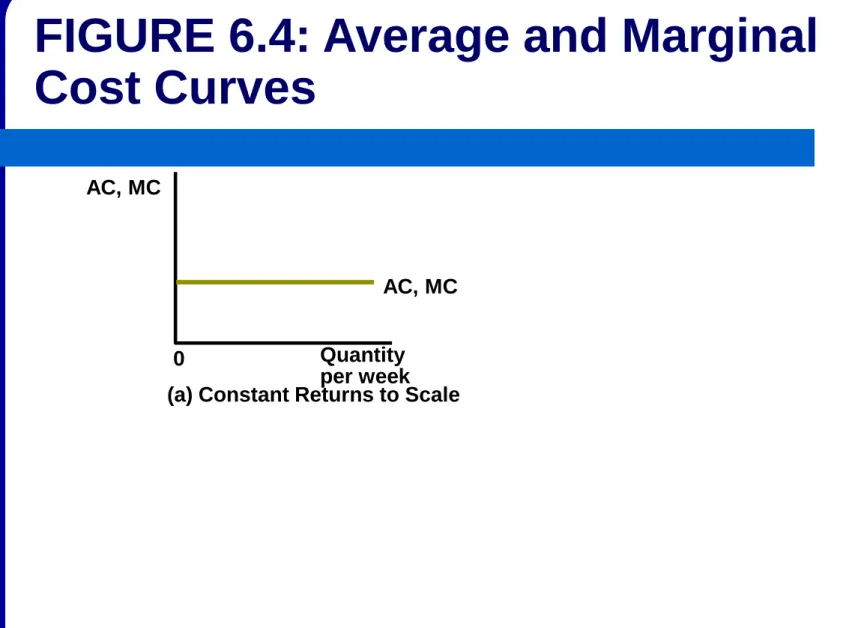Chapter 6
Costs
© 2004 Thomson Learning/South-Western
2
Basic Concepts of Costs
Opportunity cost is the cost of a good or service as measured by the alternative uses that are foregone by producing the good or service.
– If 15 bicycles could be produced with the materials used to produce an automobile, the opportunity cost of the automobile is 15 bicycles.
The price of a good or service often may reflect its opportunity cost.
3
Basic Concepts of Costs
Accounting cost is the concept that goods or services cost what was paid for them.
Economic cost is the amount required to keep a resource in its present use; the amount that it would be worth in its next best alternative use.
4
Labor Costs
Like accountants, economists regard the payments to labor as an explicit cost.
Labor services (worker-hours) are purchased at an hourly wage rate (w): The cost of hiring one worker for one hour.
The wage rate is assumed to be the amount workers would receive in their next best
alternative employment.
5
Capital Costs
While accountants usually calculate capital
costs by applying some depreciation rule to the historical price of the machine, economists
view this amount as a sunk cost.
A sunk cost is an expenditure that once made cannot be recovered.
These costs do not focus on foregone opportunities.
6
Capital Costs
Economists consider the cost of a machine to be the amount someone else would be willing to pay for its use.
The cost of capital services (machine-hours) is the rental rate (v) which is the cost of hiring one machine for one hour.
This is an implicit cost if the machine is owned by the firm.
7
Two Simplifying Assumptions
The firm uses only two inputs: labor (L, measured in labor hours) and capital (K, measured in machine hours).
– Entrepreneurial services are assumed to be included in the capital costs.
Firms buy inputs in perfectly competitive markets so the firm faces horizontal supply curves at prevailing factor prices.
8
Economic Profits and Cost Minimization
Total costs = TC = wL + vK.
Assuming the firm produces only one output, total revenue equals the price of the product
(P) times its total output [q = f(K,L) where f(K,L) is the firm’s production function].
9
Economic Profits and Cost Minimization
Economic profits () is the difference
between a firm’s total revenues and its total economic costs.
. )
, (
costs Total
- revenues Total
vK wL
L K
Pf
vK wL
Pq
10
Cost-Minimizing Input Choice
Assume, for purposes of this chapter, that the firm has decided to produce a particular output level (say, q1).
– The firm’s total revenues are P·q1.
How the firm might choose to produce this
level of output at minimal costs is the subject of this chapter.
11
Cost-Minimizing Input Choice
Cost minimization requires that the marginal rate of technical substitution (RTS) of L for K equals the ratio of the inputs’ costs, w/v:
v
RTS ( of L for K) w
12
Graphic Presentation
The isoquant q1 shows all combinations of K and L that are required to produce q1.
The slope of total costs, TC = wL + vK, is - w/v.
Lines of equal cost will have the same slope so they will be parallel.
Three equal total costs lines, labeled TC1, TC2, and TC3 are shown in Figure 6.1.
Capital per week
TC1
TC2
TC3
q1 K*
Labor per week 0 L*
14
Graphic Presentation
The minimum total cost of producing q1 is TC1 (since it is closest to the origin).
The cost-minimizing input combination is L*, K* which occurs where the total cost curve is
tangent to the isoquant.
At the point of tangency, the rate at which the firm can technically substitute L for K (the RTS) equals the market rate (w/v).
15
An Alternative Interpretation
. ,
. K)
for L
of (
v MP w
MP
v w MP
RTS MP
MP RTS MP
K L
K L
K L
From Chapter 5
Cost minimization requires
or, rearranging
16
The Firm’s Expansion Path
A similar analysis could be performed for any output level (q).
If input costs (w and v) remain constant, various cost-minimizing choices can be traces out as shown in Figure 6.2.
For example, output level q1 is produced
using K1, L1, and other cost-minimizing points are shown by the tangency between the total cost lines and the isoquants.
17
The Firm’s Expansion Path
The firm’s expansion path is the set of cost- minimizing input combinations a firm will
choose to produce various levels of output (when the prices of inputs are held constant).
Although in Figure 6.2, the expansion path is a straight line, that is not necessarily the case.
18
Capital per week
TC1 TC3 TC2
Expansion path
q1
q2 q3 K1
Labor per week L1
0
FIGURE 6.2: Firm’s Expansion Path
19
Cost Curves
A firm’s expansion path shows how minimum- cost input use increases when the level of
output expands.
With this it is possible to develop the
relationship between output levels and total input costs.
These cost curves are fundamental to the theory of supply.
20
Cost Curves
Figure 6.3 shows four possible shapes for cost curves.
In Panel a, output and required input use is proportional which means doubling of output requires doubling of inputs. This is the case when the production function exhibits constant returns to scale.
21
Total cost
TC
Quantity per week
(a) Constant Returns to Scale 0
FIGURE 6.3: Possible Shapes of the
Total Cost Curve
22
Cost Curves
Panels b and c reflect the cases of decreasing and increasing returns to scale, respectively.
With decreasing returns to scale the cost curve is convex, while the it is concave with
increasing returns to scale.
Decreasing returns to scale indicate
considerable cost advantages from large scale operations.
23
Total cost
TC
Quantity per week
(a) Constant Returns to Scale 0
Total
cost TC
Quantity per week
(b) Decreasing Returns to Scale 0
Total
cost TC
Quantity per week
(c) Increasing Returns to Scale 0
FIGURE 6.3: Possible Shapes of the
Total Cost Curve
24
Cost Curves
Panel d reflects the case where there are increasing returns to scale followed by
decreasing returns to scale.
This might arise because internal co-ordination and control by managers is initially
underutilized, but becomes more difficult at high levels of output.
This suggests an optimal scale of output.
25
Total cost
TC
Quantity per week
(a) Constant Returns to Scale 0
Total
cost TC
Quantity per week
(b) Decreasing Returns to Scale 0
Total
cost TC
Quantity per week
(c) Increasing Returns to Scale 0
Total cost
TC
Quantity per week (d) Optimal Scale 0
FIGURE 6.3: Possible Shapes of the
Total Cost Curve
26
Average Costs
Average cost is total cost divided by output; a common measure of cost per unit.
If the total cost of producing 25 units is $100, the average cost would be
q AC TC
cost Average
4 25 $
100
$
AC
27
Marginal Cost
The additional cost of producing one more unit of output is marginal cost.
If the cost of producing 24 units is $98 and the cost of producing 25 units is $100, the marginal cost of the 25th unit is $2.
q in Change
TC in
Change cost
Marginal MC
28
Marginal Cost Curves
Marginal costs are reflected by the slope of the total cost curve.
The constant returns to scale total cost curve shown in Panel a of Figure 6.3 has a constant slope, so the marginal cost is constant as
shown by the horizontal marginal cost curve in Panel a of Figure 6.4.
29
AC, MC
AC, MC
Quantity per week (a) Constant Returns to Scale
0
FIGURE 6.4: Average and Marginal
Cost Curves
30
Marginal Cost Curves
With decreasing returns to scale, the total cost curve is convex (Panel b of Figure 6.3).
This means that marginal costs are increasing which is shown by the positively sloped
marginal cost curve in Panel b of Figure 6.4.
31
AC, MC
AC, MC
Quantity per week (a) Constant Returns to Scale
0
AC, MC
AC MC
Quantity per week
(b) Decreasing Returns to Scale 0
FIGURE 6.4: Average and Marginal
Cost Curves
32
Marginal Cost Curves
Increasing returns to scale results in a concave total cost curve (Panel c of Figure 6.3).
This causes the marginal costs to decrease as output increases as shown in the negatively
sloped marginal cost curve in Panel c of Figure 6.4.
33
AC, MC
AC, MC
Quantity per week (a) Constant Returns to Scale
0
AC, MC
AC
AC
MC
MC
Quantity per week
(b) Decreasing Returns to Scale 0
AC, MC
Quantity per week
(c) Increasing Returns to Scale 0
FIGURE 6.4: Average and Marginal
Cost Curves
34
Marginal Cost Curves
When the total cost curve is first concave followed by convex as shown in Panel d of
Figure 6.3, marginal costs initially decrease but eventually increase.
Thus, the marginal cost curve is first negatively sloped followed by a positively sloped curve as shown in Panel d of Figure 6.4.
35
AC, MC
AC, MC
Quantity per week (a) Constant Returns to Scale
0
AC, MC
AC
AC
AC
MC
MC
MC
Quantity per week
(b) Decreasing Returns to Scale 0
AC, MC
Quantity per week
(c) Increasing Returns to Scale 0
AC, MC
Quantity per week (d) Optimal Scale
0 q*
FIGURE 6.4: Average and Marginal
Cost Curves
36
Average Cost Curves
If a firm produces only one unit of output,
marginal cost would be the same as average cost
Thus, the graph of the average cost curve begins at the point where the marginal cost curve intersects the vertical axis.
37
Average Cost Curves
For the constant returns to scale case,
marginal cost never varies from its initial level, so average cost must stay the same as well.
Thus, the average cost curve are the same horizontal line as shown in Panel a of Figure 6.4.
38
Average Cost Curves
With convex total costs and increasing
marginal costs, average costs also rise as shown in Panel b of Figure 6.4.
Because the first few units are produced at low marginal costs, average costs will always b
less than marginal cost, so the average cost curve lies below the marginal cost curve.
39
Average Cost Curves
With concave total cost and decreasing marginal costs, average costs will also
decrease as shown in Panel c in Figure 6.4.
Because the first few units are produced at relatively high marginal costs, average is less than marginal cost, so the average cost curve lies below the marginal cost curve.
40
Average Cost Curves
The U-shaped marginal cost curve shown in Panel d of Figure 6.4 reflects decreasing
marginal costs at low levels of output and increasing marginal costs at high levels of output.
As long as marginal cost is below average cost, the marginal will pull down the average.
41
Average Cost Curves
When marginal costs are above average cost, the marginal pulls up the average.
Thus, the average cost curve must intersect the marginal cost curve at the minimum
average cost; q* in Panel d of Figure 6.4.
Since q* represents the lowest average cost, it represents an “optimal scale” of production for the firm.
42
Distinction between the Short Run and the Long Run
The short run is the period of time in which a firm must consider some inputs to be
absolutely fixed in making its decisions.
The long run is the period of time in which a firm may consider all of its inputs to be variable in making its decisions.
43
Holding Capital Input Constant
For the following, the capital input is assumed to be held constant at a level of K1, so that,
with only two inputs, labor is the only input the firm can vary.
As examined in Chapter 5, this implies diminishing marginal productivity to labor.
44
Types of Short-Run Costs
Fixed costs; costs associated with inputs that are fixed in the short run.
Variable costs; costs associated with
inputs that can be varied in the short
run.
45
Input Inflexibility and Cost Minimization
Since capital is fixed, short-run costs are not the minimal costs of producing variable output levels.
Assume the firm has fixed capital of K1 as shown in Figure 6.5.
To produce q0 of output, the firm must use L1 units of labor, with similar situations for q1, L1, and q2, L2.
46
Capital per week
STC0 STC1 STC2
q1
q2
q0 K1
Labor per week
L0 L1 L2
0
FIGURE 6.5: “Nonoptimal” Input
Choices Must Be Made in the Short Run
47
Input Inflexibility and Cost Minimization
The cost of output produced is minimized
where the RTS equals the ratio of prices, which only occurs at q1, L1.
Q0 could be produce at less cost if less capital than K1 and more labor than L0 were used.
Q2 could be produced at less cost if more capital than K1 and less labor than L2 were used.
48
Per-Unit Short-Run Cost Curves
q in Change
STC in
Change cost
marginal run
- Short and
cost average
run -
Short
SMC
q
SAC STC
49
Per-Unit Short-Run Cost Curves
Having capital fixed in the short run yields a total cost curve that has both concave and convex sections, the resulting short-run
average and marginal cost relationships will also be U-shaped.
When SMC < SAC, average cost is falling, but when SMC > SAC average cost increase.
50
Relationship between Short-Run and Long-Run per-Unit Cost Curves
Figure 6.6 shows all cost relationships for a firm that has U-shaped long-run average and marginal cost curves.
At output level q* long-run average costs are minimized and MC = AC.
Associated with q* is a certain level of capital, K*.
51
SMC MC
SAC
AC AC, MC
Quantity per week
0 q*
FIGURE 6.6: Short-Run and Long-Run Average and Marginal Cost Curves at Optimal Output Level
52
Relationship between Short-Run and Long-Run per-Unit Cost Curves
In the short-run, when the firm using K* units of capital produces q*, short-run and long-run
total costs are equal.
In addition, as shown in Figure 6.6 AC = MC = SAC(K*) = SMC(K*).
For output above q* short-run costs are higher than long-run costs. The higher per-unit costs reflect the facts that K is fixed.
53
Shifts in Cost Curves
Any change in economic conditions that affects the expansion path will also affect the shape
and position of the firm’s cost curves.
Three sources of such change are:
– change in input prices
– technological innovations, and
– economies of scope.
54
Changes in Input Prices
A change in the price of an input will tilt the firm’s total cost lines and alter its expansion path.
For example, a rise in wage rates will cause
firms to use more capital (to the extent allowed by the technology) and the entire expansion
path will rotate toward the capital axis.
55
Changes in Input Prices
Generally, all cost curves will shift upward with the extent of the shift depending upon how
important labor is in production and how successful the firm is in substituting other inputs for labor.
– With important labor and poor substitution
possibilities, a significant increase in costs will result.
56
Technological Innovation
Because technological advances alter a firm’s production function, isoquant maps as well as the firm’s expansion path will shift when
technology changes.
Unbiased improvements would shift isoquants toward the origin enabeling firms to produce the same level of output with less of all inputs.
57
Technological Innovation
Technological change that is biased toward the use of one input will alter isoquant maps, shift expansion paths, and affect the shape and
location of cost curves.
– For example, if workers became more skilled, this would save only on labor input.
58
Economies of Scope
Economies of scope is the reduction in the costs of one product of a multiproduct firm when the output of another product is
increased.
– For example, when hospitals do many surgeries of one type, it may have cost advantages in doing
other types because of the similarities in equipment and operating personnel used.
59
A Numerical Example
Assume Hamburger Heaven (HH) can hire workers at $5 per hour and it rents all of its grills for $5 per hour.
Total costs for HH during one hour are TC = 5K + 5L
where K and L are the number of grills and the number of workers hired during that hour,
respectively.
60
A Numerical Example
Suppose HH wishes to produce 40 hamburgers per hour.
Table 6.1 repeats the various ways HH can produce 40 hamburgers per hour.
– This shows that total costs are minimized when K = L = 4.
Figure 6.10 shows the cost-minimizing tangency.
61
TABLE 6.1: Total Costs of Producing 40 Hamburgers per Hour
Output (q) Workers (L) Grills (K) Total Cost (TC)
40 1 16.0 $85.00
40 2 8.0 50.00
40 3 5.3 41.50
40 4 4.0 40.00
40 5 3.2 41.00
40 6 2.7 43.50
40 7 2.3 46.50
40 8 2.0 50.00
40 9 1.8 54.00
40 10 1.6 58.00
62
Grills per hour
2 8
4
Workers per hour
40 hamburgers per hour E
Total cost = $40
2 4 8
0
Figure 6.7: Cost-Minimizing Input
Choice for 40 Hamburgers per Hour
63
Long-Run cost Curves
HH’s production function is constant returns to scale so
As long as w = v = $5, all of the cost
minimizing tangencies will resemble the one shown in Figure 6.10 and long-run cost
minimization will require K = L.
64
Long-Run cost Curves
This situation, resulting from constant returns to scale, is shown in Figure 6.8.
HH’s long-run total cost function is a straight line through the origin as shown in Panel a.
Its long-run average and marginal costs are constant at $1 per burger as shown in Panel b.
65
Total costs
20 60
$80
40
Total costs
40 60
20 80
(a) Total Costs
0
Average and marginal costs
$1.00
Hamburgers per hour 40 60
20 80
(b) Average and Marginal Costs
0
FIGURE 6.8: Total, Average, and Marginal Cost Curves
Average and marginal costs Hamburgers
per hour
66
Short-Run Costs
Table 6.2 repeats the labor input required to produce various output levels holding grills fixed at 4.
Diminishing marginal productivity of labor
causes costs to rise rapidly as output expands.
Figure 6.9 shows the short-run average and marginal costs curves.
67
TABLE 6.2: Short-Run Costs of Hamburger Production
Output (q)
Workers (L)
Grills (K)
Total Cost (STC)
Average Cost (SAC)
Marginal Cost (SMC)
10 0.25 4 $21.25 $2.125 -
20 1.00 4 25.00 1.250 $0.50
30 2.25 4 31.25 1.040 0.75
40 4.00 4 40.00 1.000 1.00
50 6.25 4 51.25 1.025 1.25
60 9.00 4 65.00 1.085 1.50
70 12.25 4 81.25 1.160 1.75
80 16.00 4 100.00 1.250 2.00
90 20.25 4 121.25 1.345 2.25
100 25.00 4 145.00 1.450 2.50
68
Average and marginal costs
.50 1.00
$2.50
2.00 1.50
Hamburgers per hour SMC (4 grills)
SAC (4 grills)
AC, MC
40
20 60 80 100
0
FIGURE 6.12: Short-Run and Long-Run Average and Marginal Cost Curves for Hamburger Heaven









